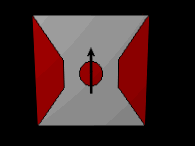
Materials Research Science and Engineering Center: Faculty Publications
Document Type
Article
Date of this Version
2007
Abstract
Exchange-spring nanocomposite permanent magnets have received a great deal of attention for their potential for improved the energy products. Predicted results, however, has been elusive. Optimal properties rely on a uniformly fine nanostructure. Particularly, the soft magnetic phase must be below approximately 10 nm to ensure complete exchange coupling. Inert gas condensation (IGC) is an ideal processing route to produce sub-10 nm clusters method. Two distinct nanostructures have been produced. In the first, Fe clusters were embedded in an FePt matrix by alternate deposition from two sources. Fe cluster content ranged from 0 to 30 volume percent. Post-deposition multi-step heat treatments converted the FePt from the A1 to L10 structure. An energy product of approximately 21 MGOe was achieved. Properties deteriorated rapidly at cluster concentrations above 14 volume due to uncoupled soft magnetic regions (from cluster-cluster contacts) and cooperative reversal. The second nanostructure, designed to overcome those disadvantages, involved intra-cluster structuring. Here, Fe-rich Fe-Pt clusters separated by C or SiO2 were fabricated. Phase separation into Fe3Pt and FePt and ordering was induced during post-deposition multi-step heat treatments. By confining the soft and hard phases to individual clusters, full exchange coupling was accomplished and cooperative reversal between clusters was effectively eliminated. An energy product of more than 25 MGOe was achieved, and the volume fraction of the soft phase was increased to greater than 0.5 while maintaining a coercivity of 6.5 kOe. The results provide new insight into developing high energy product nanostructured permanent magnets.


Comments
Published in Mater. Res. Soc. Symp. Proc. Vol. 962. Copyright © 2007 Materials Research Society. Used by permission.